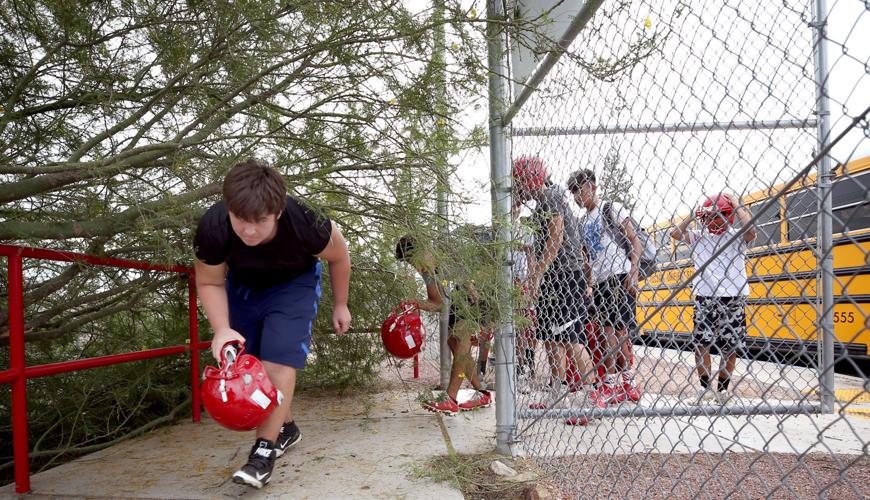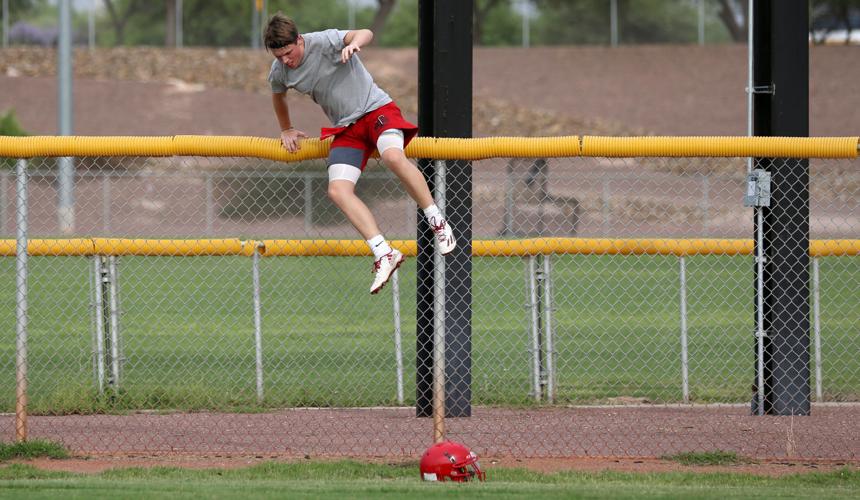During last week’s storms, people were calling Rollin Gridley Stadium at Tucson Magnet High School “Gridley Lake.”
The floodwaters that covered the football field near downtown have receded, but the 111-year-old field — converted to artificial turf for $1 million a decade ago — remains out of service.
The school’s football team hasn’t practiced there since the field was drenched on July 19 by a massive storm that put it and nearby neighborhoods under a foot of water or more.
It’s not known when the field will be used again for Badgers football practice, or what caused the storm damage to be so severe, a district spokeswoman said Wednesday.
Pima County Administrator Chuck Huckelberry and a maintenance worker at Tucson High said one cause was that storm drains on the field were clogged with wood and other debris.
The district is taking a look at Huckelberry’s written assessment and conducting its own inquiry, said Tucson Unified School District spokeswoman Stefanie Boe. The district is also assessing the field’s conditions with its insurer.
There’s no timeline for repair yet.
“We will not reopen the field until we are certain it’s safe for our students, staff and visitors,” Boe said in an email. “The closure of the field is out of an abundance of caution while we conduct our investigation and work with local officials and our insurer on next steps.”
Boe didn’t elaborate on the safety question and didn’t respond to Star requests for more details.
For now, the football team is practicing at Cherry Field, near East 13th Street and South Cherry Avenue south of Broadway. The team’s season starts at the end of August.
Stormwater runoff is known in many places to carry pollutants such as oil, pesticides, sediments, bacteria and other chemicals picked up from asphalt when it runs over streets, sidewalks and other impervious surfaces. It also can contain nitrogen and phosphorus pollutants from fertilizers, and pet and yard waste, the Environmental Protection Agency has said.
The stadium itself has a storied history, having played host to some of the region’s most memorable high school football games over the decades. Two years ago, Tucson High football coach Justin Argraves told the Star, “I get goosebumps every time we take the field; it never gets old.”
He didn’t respond to interview requests this week about the flooding.
The field lies in a floodplain, Tucson flood maps show, making it more susceptible to flooding than areas on higher ground.
Yet Gloria Ellison, who has owned a house across Euclid Avenue from the high school since 1961, said she has never seen flooding as severe at the football field, although she has seen it at her house before.
Ellison’s house also took in floodwaters last week and its yard, too, resembled a lake. Not only did the water blanket her two driveways, gravel front yard and small backyard pool with mud, it also streamed into a guesthouse, she said.
In a memo this week, Huckelberry wrote that the football field’s flooding stemmed from “an intense rain event” that sent very heavy sheets of floodwater from the entire West University neighborhood that lies north and west of the high school. The same storm sent floodwaters roaring down North Fourth Avenue and forced a shutdown of the streetcar for 30 to 40 minutes in that area.
County staffers who visited the site found grates near the field were covered with debris that may have washed in from the sheet flooding, Huckelberry wrote.
Storm grates into the neighboring drainage system lie about every 125 feet around the football field, but photos taken by the county showed pieces of wood clogging the grates.
Rocks, car parts and clothing also turned up at the storm drain grates last week, added Joe Federico, who said he’s the school’s lead groundskeeper.
“They need to clean out the drains and put in better pipes,” Federico said. “They need to put something in to take out all that water.”
Andy Dinauer of the county Regional Flood Control District said he doesn’t know whether the flooding occurred because the storm drain grates weren’t adequately maintained before the storms hit, or if the debris simply came off the streets during the big storm.
But he said the high school storm drains had enough capacity to handle the stormwater flows.
“It’s a complete system over there. It was wonderfully done. It’s that the inlets were clogged with debris,” said Dinauer, the department’s acting deputy director.
Another factor in the flood damage is that the artificial turf has a rubberized base below the surface, leaving very little capacity for stormwater to infiltrate into the aquifer, Huckelberry wrote in his memo.
Plus, several temporary buildings on the site likely retarded the stormwater runoff flows and aggravated the ponding of water on the field, he said.
The field lies just north of a much larger $4 million storm drain project, completed in 2015, that more than tripled the amount of box culverts to handle runoff.
It was built as part of the $60 million Arroyo Chico flood control project that spans six miles west from Reid Park almost to downtown.
That storm drainage project worked well during the flooding and could have handled the football field’s floodwater if the field’s drains hadn’t been clogged, Huckelberry said.
One project that could improve storm drainage in the area of the high school is the city’s upcoming Downtown Links roadway project to build a new, limited access, four-lane road in that area from Broadway to Church Avenue, city officials say. Earlier phases of that project added new storm drains and box culverts in areas east and west of downtown.
The road project, which could start as soon as December, will add additional drainage improvements from High School Wash — which runs south of Tucson High — to the Tucson Arroyo west of downtown, said Michael Graham, a city Transportation Department spokesman. The entire project will cost $87.5 million.







